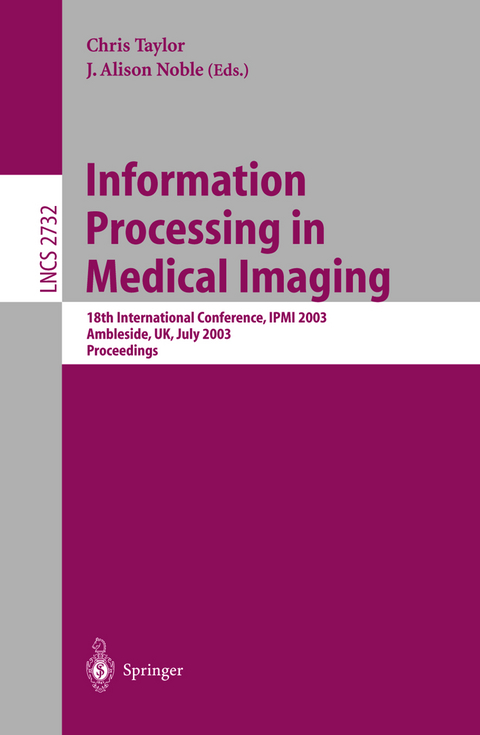
Information Processing in Medical Imaging
Springer Berlin (Verlag)
978-3-540-40560-3 (ISBN)
Shape Modelling.- Shape Modelling Using Markov Random Field Restoration of Point Correspondences.- Optimal Deformable Surface Models for 3D Medical Image Analysis.- Learning Object Correspondences with the Observed Transport Shape Measure.- Shape Discrimination in the Hippocampus Using an MDL Model.- Posters I: Shape Modelling and Analysis.- Minimum Description Length Shape and Appearance Models.- Evaluation of 3D Correspondence Methods for Model Building.- Localization of Anatomical Point Landmarks in 3D Medical Images by Fitting 3D Parametric Intensity Models.- Morphology-Based Cortical Thickness Estimation.- The Shape Operator for Differential Analysis of Images.- Feature Selection for Shape-Based Classification of Biological Objects.- Corresponding Articular Cartilage Thickness Measurements in the Knee Joint by Modelling the Underlying Bone (Commercial in Confidence).- Adapting Active Shape Models for 3D Segmentation of Tubular Structures in Medical Images.- A Unified Variational Approach to Denoising and Bias Correction in MR.- Shape Analysis.- Object-Based Strategy for Morphometry of the Cerebral Cortex.- Genus Zero Surface Conformal Mapping and Its Application to Brain Surface Mapping.- Segmentation.- Coupled Multi-shape Model and Mutual Information for Medical Image Segmentation.- Neighbor-Constrained Segmentation with 3D Deformable Models.- Expectation Maximization Strategies for Multi-atlas Multi-label Segmentation.- Quantitative Analysis of Intrathoracic Airway Trees: Methods and Validation.- Posters II: Segmentation, Colour, and Performance.- Multi-view Active Appearance Models: Application to X-Ray LV Angiography and Cardiac MRI.- Tunnelling Descent: A New Algorithm for Active Contour Segmentation of Ultrasound Images.- Improving Appearance Model Matching Using Local Image Structure.- Knowledge-Driven Automated Extraction of the Human Cerebral Ventricular System from MR Images.- Volumetric Texture Description and Discriminant Feature Selection for MRI.- CAD Tool for Burn Diagnosis.- An Inverse Method for the Recovery of Tissue Parameters from Colour Images.- Ideal Observer Model for Detection of Blood Perfusion and Flow Using Ultrasound.- Permutation Tests for Classification: Towards Statistical Significance in Image-Based Studies.- Performance Characterisation.- Ideal-Observer Performance under Signal and Background Uncertainty.- Theoretical Evaluation of the Detectability of Random Lesions in Bayesian Emission Reconstruction.- Registration - Modelling Similarity.- A Unified Statistical and Information Theoretic Framework for Multi-modal Image Registration.- Information Theoretic Similarity Measures in Non-rigid Registration.- A New & Robust Information Theoretic Measure and Its Application to Image Alignment.- Gray Scale Registration of Mammograms Using a Model of Image Acquisition.- Registration - Modelling Deformation.- Constructing Diffeomorphic Representations of Non-rigid Registrations of Medical Images.- Topology Preservation and Regularity in Estimated Deformation Fields.- Large Deformation Inverse Consistent Elastic Image Registration.- Gaussian Distributions on Lie Groups and Their Application to Statistical Shape Analysis.- Posters III: Registration, Function, and Motion.- Non-rigid Image Registration Using a Statistical Spline Deformation Model.- A View-Based Approach to Registration: Theory and Application to Vascular Image Registration.- Meshfree Representation and Computation: Applications to Cardiac Motion Analysis.- Bayesian Multimodality Non-rigid Image Registration via Conditional DensityEstimation.- Spatiotemporal Localization of Significant Activation in MEG Using Permutation Tests.- Symmetric BEM Formulation for the M/EEG Forward Problem.- Localization Estimation Algorithm (LEA): A Supervised Prior-Based Approach for Solving the EEG/MEG Inverse Problem.- Multivariate Group Effect Analysis in Functional Magnetic Resonance Imaging.- Meshfree Representation and Computation: Applications to Cardiac Motion Analysis.- Visualization of Myocardial Motion Using MICSR Trinary Checkerboard Display.- Velocity Estimation in Ultrasound Images: A Block Matching Approach.- Cardiac Motion.- Construction of a Statistical Model for Cardiac Motion Analysis Using Nonrigid Image Registration.- Fast Tracking of Cardiac Motion Using 3D-HARP.- fMRI Analysis.- Analysis of Event-Related fMRI Data Using Best Clustering Bases.- Estimation of the Hemodynamic Response Function in Event-Related Functional MRI: Directed Acyclic Graphs for a General Bayesian Inference Framework.- Nonlinear Estimation and Modeling of fMRI Data Using Spatio-temporal Support Vector Regression.- Diffusion Imaging and Tractography.- A Constrained Variational Principle for Direct Estimation and Smoothing of the Diffusion Tensor Field from DWI.- Persistent Angular Structure: New Insights from Diffusion MRI Data. Dummy Version.- Probabilistic Monte Carlo Based Mapping of Cerebral Connections Utilising Whole-Brain Crossing Fibre Information.
| Erscheint lt. Verlag | 11.7.2003 |
|---|---|
| Reihe/Serie | Lecture Notes in Computer Science |
| Zusatzinfo | XVI, 698 p. |
| Verlagsort | Berlin |
| Sprache | englisch |
| Maße | 155 x 233 mm |
| Gewicht | 993 g |
| Themenwelt | Informatik ► Grafik / Design ► Digitale Bildverarbeitung |
| Schlagworte | 3D • Bayesian inference • brain imaging • Cardiac Imaging • Computer Version • Diagnosis • Image Analysis • Magnetic Resonance Imaging • Medical Image Analysis • Medical Image Computing • Medical Image Processing • medical image registration • Medical Image Sequences • Medical Imaging • MRI • Radiologieinformationssystem • Radiology • Visualization |
| ISBN-10 | 3-540-40560-7 / 3540405607 |
| ISBN-13 | 978-3-540-40560-3 / 9783540405603 |
| Zustand | Neuware |
| Informationen gemäß Produktsicherheitsverordnung (GPSR) | |
| Haben Sie eine Frage zum Produkt? |
aus dem Bereich


